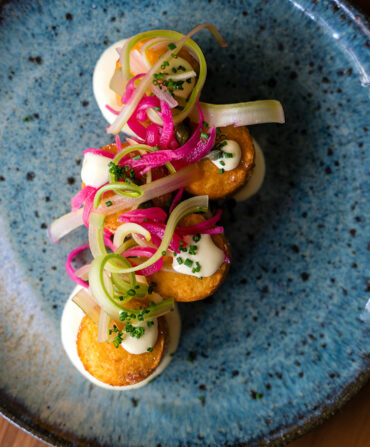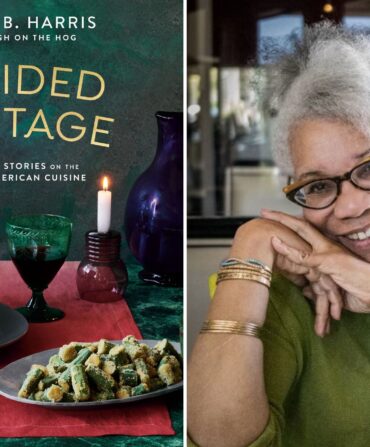Hands down, the best word I learned in the past year was tracas.
Tracas (pronounced tra-cah or, sometimes, thra-cah) derives from the French tracasser, “to worry,” but the noun takes on a different cast in Cajun French. In the pockets of Acadiana where it’s used, tracas denotes agitation, fuss, trouble. And there’s also another element: “A tracas is something you’re obsessively annoyed by,” a friend who grew up deep in the bayou tells me. “It’s often related to food: the way people cook certain things.”
I did not need to be told this last part, because where I first encountered tracas was in the context of what I call the Gumbo Wars. That is, debates about what gumbo is, how to make it, and, especially, what gumbo isn’t. There are other foods, of course, that ignite passionate discussion, especially ones deeply tied to a regional or ethnic identity. But while grits may inspire fussin’, bagels cause their share of mishegoss, and pizza leads to no shortage of agita, nothing in this world creates more tracas than the question of gumbo.
This, like termite swarms and SEC football recruiting, was something of which I was blissfully unaware before moving to New Orleans a dozen years ago. In my Brooklyn apartment, I made various versions of gumbo without thinking for a moment that I was choosing sides in any kind of culinary culture war. I was naive.
“It’s one of those things that, if I’m going to write about it, I just brace myself,” says Ann Maloney, who was a food columnist at the New Orleans Times-Picayune and is now recipes editor for the Washington Post. Maloney is from New Orleans and her husband from Cut Off, a fishing community in Lafourche Parish. That is to say, she can write about gumbo with some authority. “I am very confident in my bona fides,” she says. Nevertheless, she knows the fuse she’s lighting when she publishes a gumbo recipe. “It can get really personal. Like, people call you an idiot. Sometimes they’re joking around, but sometimes it gets really kind of…intense.”
What do people fight about? Name it: How to make a roux. What color that roux should be. Whether to use roux or, instead, okra or filé. Whether you can use roux and okra and filé. What proteins are permissible and in what combinations. Rice or potato salad? Rice on top or underneath? Eggs or no eggs? And that’s just among Louisianans. God forbid somebody from north of I-10 try to weigh in. The ultimate example of that came in 2016, when an ill-fortuned recipe developer/social media person at Disney created something called Tiana’s Healthy Gumbo, named for the heroine of The Princess and the Frog. The recipe featured kale and quinoa and nearly caused half of South Louisiana’s heads to explode.
Oh, and tomatoes. They fight a lot about tomatoes. I did not realize the degree to which tomatoes had become the third rail of gumbo until I started spending time on the Facebook group Cajun Meme Factory, where some of the most entertaining and vicious skirmishes of the Gumbo Wars take place. “For some reason, this poor fruit gets beaten up more than anything,” says one of the group’s moderators, Shawn Delahoussaye. “It’s the redheaded step-tomato.” The conflict hinges on the divide between New Orleans Creole gumbo (which often incorporates tomatoes) and the rural, largely tomato-less style found in Cajun Country. “It’s Country Mouse versus City Mouse,” says Delahoussaye, who grew up in New Iberia. “And it’s not like Cajuns don’t cook with tomatoes. They love tomatoes. They love all kinds of tomatoes. It’s just that, somewhere along the line, some Cajun got it in their head that there’s no tomatoes in gumbo.” That this is manifestly untrue, in recipes (including from sources as unimpeachably Cajun as Paul Prudhomme) going back more than a century, is of little consequence.
It’s strange: that a dish born out of making the best out of whatever ingredients are at hand, whose very name has become a metaphor for the blending of traditions in the great cultural pot, has created such strongly held orthodoxies. Sara Roahen, who wrote the book Gumbo Tales: Finding My Place at the New Orleans Table and compiled dozens of oral histories about gumbo for the Southern Foodways Alliance, has heard them all. “There’s not a rule that I’ve ever heard that I didn’t see completely broken,” she says. “And broken by somebody who knew a lot more about gumbo than I do.”
But, of course, gumbo is connected not only to regional pride but to deep familial nostalgia. It is taken as a given that one’s family makes the only true gumbo, and that any discussion begins with the notion of second place. Such things breed passionate stances. (Imagine if every Brooklynite and Chicagoan not only had strong opinions about pizza but also had a mother who made her own version at home.)
Another supposedly inviolable gumbo rule is a strict line between gumbos that contain poultry and sausage and those that contain seafood. But this border is crossed all the time, particularly in the African American gumbos of New Orleans. One of my favorites is made by Kristi Givens, who grew up in the Seventh Ward and traces her gumbo at least back to her great-grandmother. It knows no borders of land and sea, containing slices of smoked sausage, little balls of hot sausage, chicken necks and chicken gizzards, but also shrimp, crab, and a shrimp stock. She even boosts the flavor with a pinch of seafood seasoning. Givens happens to own and run the early learning center that both my daughters attended, Kids of Excellence. No longer squeezing myself into a chair made for four-year-olds to enjoy her gumbo at the annual Thanksgiving lunch for families may be the greatest regret I have about the girls growing up.
Yet even Givens has limits. She draws the line at cocktail weenies and oxtail—both of which make occasional appearances in local pots. “That’s not gumbo,” she says. This illustrates another truth and paradox about the Gumbo Wars. Even the most liberal in principle tend to become conservative when it comes to the particular. “You can put everything in gumbo!” says Judy Walker, a retired Times-Picayune food editor and columnist and the coauthor of Cooking Up a Storm: Recipes Lost and Found from the “Times-Picayune” of New Orleans. She goes on to cite historical gumbos with such ingredients as ham, cabbage, and even milk. “All of these were legitimate gumbos,” she says, then pauses. “Well, I mean, you can’t put corn.” Ann Maloney believes in great gumbo freedom but is dubious about crawfish. A Cajun friend of mine who is perfectly fine with all manner of other variations professes to become physically ill at the thought of putting fish in gumbo.
I don’t mean to suggest that you should put flounder or hot dogs or corn in your gumbo (though I personally like the hot dogs), only to say that, after a while, you may begin to wonder if gumbo is both everything and nothing, a land without walls but rather ever-shifting borders. You may wonder if the only absolute truth is that you know gumbo when you see it.
“What matters is that it’s an honest gumbo,” says Shawn Delahoussaye. “Gumbo wasn’t for kings and queens. This is a low-country food. So, you’re not going to make a pheasant and truffle gumbo. That might be a tasty food, but it’s not going to be an honest gumbo.”
Then again, one of the best gumbos I know is the pheasant, quail, and andouille (though admittedly not truffle) gumbo served at Jazz Fest every year and made by Prejean’s, one of the oldest Cajun restaurants there is. So maybe the last word is something Sara Roahen, of Gumbo Tales, whispered to me many years ago—something I’ve turned over in my mind ever since, like a koan.
“Gumbo,” she said, “is infinite.”








